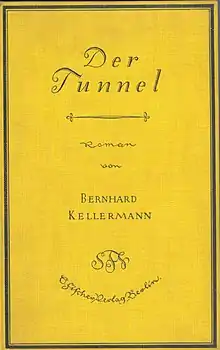Der Tunnel (novel)
Der Tunnel is a novel by Bernhard Kellermann published in April 1913. The novel sold 100,000 copies in the six months after its publication, and it became one of the most successful books of the first half of the 20th century. By 1939 its circulation had reached millions. The main theme of the novel is social progress, particularly with respect to modern technology.

Plot
Allan, an idealistic engineer, wants to build a tunnel at the bottom of the Atlantic Ocean connecting North America with Europe within a few years. The idealist's scheme is thwarted for financial reasons, and the tunnel construction (in particular a segment dug under a mountain) experiences several disasters. A fiasco seems inevitable, the army of workers revolt, and Allan becomes a figure of universal hatred throughout the world. After 26 years of construction, the tunnel is finally completed; however, the engineering masterpiece is outdated as soon as it opens, as aeroplanes now cross the Atlantic in a few hours.
Reception
The reception of the book and its sentiments was extremely positive, and was on its publication a success for Kellerman. The story anticipated important social events as the Great Depression, and had the charm of a parallel world history of a 1920s and 1930s in which the First World War never occurred. It also made the critical observation that technology always becomes outdated with its application.
Controversy
A controversial aspect of the book was its thinly-veiled racist overtones in the character of S. Woolf, Allan's nemesis. Woolf is a financial magnate who emigrated from Eastern Europe, and was portrayed as immoral and perverted. These were common Jewish stereotypes at the time Kellerman wrote.
Rudolf Olden, in his book Hitler the Pawn, says that Adolph Hitler while living in Vienna viewed Der Tunnel, a German movie adaptation based on this book. Olden says Hitler talked about it for days and was mesmerized by the lead character “who rouses the working masses by his speeches.” The author points out that that was ten years before “he himself put the power of spoken word to the proof.”[1]
Film adaptations

Four films have been based on the book. The first was The Tunnel in 1915, a silent film directed by William Wauer. Three films were released in 1933 and 1935, one version each in German (Der Tunnel),[2] French (Le Tunnel) and English (The Tunnel, renamed Transatlantic Tunnel in the US). The French and German versions were directed by Curtis Bernhardt and the English by Maurice Elvey. At the time it was not unusual to release a film in separate versions in different languages, each using different actors or directors, but utilising the same sets and locations.
See also
References
- Olden, Rudolf; et al. (Peter Hans Olden, brother) (1936). Hitler the Pawn (English Translation ed.). London: Victor Gollancz. p. 51.
- Erickson, Hal (2008). "Der Tunnel (1933)". Movies & TV Dept. The New York Times. Archived from the original on 2008-04-07. Retrieved 2009-06-01.